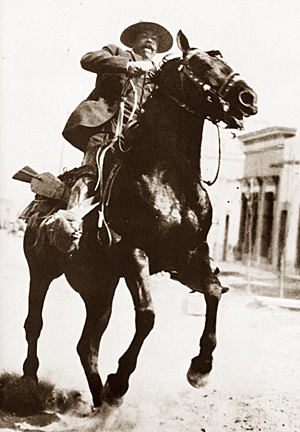 Pancho Villa, sometime outlaw and sometime folk hero,
so the saying goes, was "hated by thousands and loved by
millions." The mere mention of his name conjures up tales of daring and
kindness, treachery and lawlessness. Like Robin Hood, who stole from the
rich and gave to the poor, Villa helped northern Mexico’s less fortunate,
and they repaid him by keeping his name alive in legends. Some call him
half-man half-wolf, others the Centaur of the North. Pancho Villa, sometime outlaw and sometime folk hero,
so the saying goes, was "hated by thousands and loved by
millions." The mere mention of his name conjures up tales of daring and
kindness, treachery and lawlessness. Like Robin Hood, who stole from the
rich and gave to the poor, Villa helped northern Mexico’s less fortunate,
and they repaid him by keeping his name alive in legends. Some call him
half-man half-wolf, others the Centaur of the North.
As I stand staring at the his bullet-ridden, black Dodge
Roadster, the car which Villa was driving when seven men gunned him down
while on the way to friend’s child’s christening, I can’t help but
wonder what lies behind the larger than life legends that surround him.
One of the few things about Villa's life which most
historians agree is that he was born in 1878, in San Juan del Rio in the
State of Durango, on the Rancho de la Coyotoda, owned by the Lopez Negrete
family, to his sharecropper parents Agustin Arango and Micaela Arambula.
They baptized him Doroteo Arango.
Villa's Early Life
The legends begin on September 22, 1894 when he was 16 years old. According
to Villa years later, as he dictated his autobiography to his secretary,
Manuel Bauche Alcalde, "this is when the tragedy of my life
begins." After his father died, Doroteo became the head of his family,
working as a sharecropper on the Hacienda de Gogojito. Coming home from work
one day he found his mother and the ranch owner, Lopez Negrete, arguing. The
ranch owner apparently desired certain "favors" from Doroteo’s
12-year old sister, Martina. Doroteo became angry and shot Negrete in the
foot, then fled into the Sierra de la Silla to evade the rurales,
President Diaz’s notorious rural police. Thus he began life as an outlaw
and the legends began.
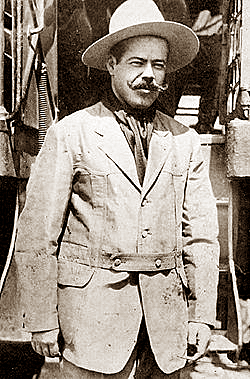 He soon became a cattle rustler and later joined a band of
rustlers led by a man named Francisco "Pancho" Villa. In one of
their many skirmishes with the law, the rurales surprised them and
killed Francisco. Doroteo then took command of the gang and also assumed the
fallen leader’s name. He may have done this to throw off those who hunted
him for shooting the hacienda owner or he may have done this to insure his
authority over the group. But from that time on he became known as Francisco
"Pancho" Villa. He soon became a cattle rustler and later joined a band of
rustlers led by a man named Francisco "Pancho" Villa. In one of
their many skirmishes with the law, the rurales surprised them and
killed Francisco. Doroteo then took command of the gang and also assumed the
fallen leader’s name. He may have done this to throw off those who hunted
him for shooting the hacienda owner or he may have done this to insure his
authority over the group. But from that time on he became known as Francisco
"Pancho" Villa.
By the time he was 20, Villa had moved northward to
Chihuahua, working on and off as a miner in Parral while selling stolen
cattle in Chihuahua. In 1899 he returned to mining, this time in Santa
Eulalia near Chihuahua, but he soon tired of the laborer's life and added
bank robbery to cattle rustling and murder on his list of crimes.
Other legends have Villa becoming the idol of the peasants
during his outlaw period from 1900-1909. They tell of how he and his gang
would attack rich haciendas and distribute the loot to the poor peons. Other
stories tell of Villa stealing cattle herds for the poor so they would have
meat to feed their families. They say he recruited gang members out in the
middle towns, similar to what an army general might do when trying to sign
up recruits.
Legends say that when Villa found a traitor in his midst,
he would quickly kill him and his brothers. He would then hunt down the
remaining male members of the traitor's family until he exterminated them
all. Besides fear from the peasants, Villa also made many enemies, some of
whom may have plotted against him in later years.
Villa ruled over northern Mexico like a medieval warlord
from his base in Chihuahua. He financed his "army" by stealing
from the endless cattle herds in northern Mexico and selling beef north of
the border, where he found plenty of U.S. merchants willing to sell him guns
and ammunition. Faced with a stagnant economy, he issued his own money. If
merchants refused to take it, they risked being shot. His friend Rodolfo
Fierro, best known by his nickname "El Carnicero" ("the
Butcher") handled executions, which Villa often ordered on a whim. In
true Robin Hood style, he broke up the vast land holdings of local hacendados
and parceled them out to the widows and orphans of his fallen soldiers.
During fiestas the mustachioed legend would dance all
night with female camp followers, although he didn't drink. When Emiliano
Zapata insisted Villa join him in a toast when their two armies met outside
Mexico City in December 1914, Villa gagged on a swig of brandy. He was an
avid swimmer and would run to stay in shape. According to Villa's last
surviving widow, he officially married 25 times, but only had 25 children.
In fact, he married twice a year between 1910 in 1923.
Villa and the Mexican Revolution
In November 1910, the Mexican Revolution began in the state of Chihuahua as
poor peasants became frustrated with the high cost of food and continued
mistreatment by the rich landowners. Their anger finally erupted into
violence. The revolutionaries quickly organized and elected their military
leaders.
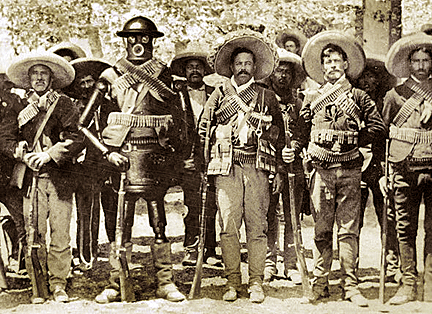 They voted Pancho Villa, then working as a butcher, as a
First Commander, leading 28 men. The 32-year-old Villa, had much experience
leading men who had but one goal in mind, victory. Villa also had the
reputation of being one of Mexico's best gunfighters. One of friends later
said, "His gun was more important to him than eating and
sleeping." They voted Pancho Villa, then working as a butcher, as a
First Commander, leading 28 men. The 32-year-old Villa, had much experience
leading men who had but one goal in mind, victory. Villa also had the
reputation of being one of Mexico's best gunfighters. One of friends later
said, "His gun was more important to him than eating and
sleeping."
Quickly seen as a guerrilla fighter, Villa became one of
the most important military leaders of the Mexican Revolution, becoming the first to defeat
government soldiers. Villa's contingent soon numbered nearly 500 as his men
won continual battles. Villa and the Dorados, "the golden Ones," his
ferocious cavalry, would attack, firing accurately at a full gallop from
their charging horses in the style of warfare perfected by the Apache and
Comanches who the Dorados' fathers had fought a generation earlier.
By 1913 Villa led a revolutionary force numbering about
3,000. Known as the División del Norte,
they used strong cavalry charges and successfully attacked at night. This
seriously damaged the morale of the federal troops.
A strong leader who made his presence known to all, Villa
would surprise his men and sit down at one of the campfires where they were
making their food. He would ask if he could join them and then sat down
alongside and eat whatever they had. This made him very popular among the
troops and also made sure he would not be poisoned.
 The battle for Torreon made Villa a national leader. By
this time he led 16,000 revolutionary soldiers, who attacked night and day
using bloody hand-to-hand combat. The federal leaders withdrew about 4,000
troops and replaced them with 6,000 fresh ones. They soon became weary and
feared the night attacks. After ten days and nights of engagement, Villa's
fighters rejoiced in their apparent victory as the federal army withdrew to
the south. The battle for Torreon made Villa a national leader. By
this time he led 16,000 revolutionary soldiers, who attacked night and day
using bloody hand-to-hand combat. The federal leaders withdrew about 4,000
troops and replaced them with 6,000 fresh ones. They soon became weary and
feared the night attacks. After ten days and nights of engagement, Villa's
fighters rejoiced in their apparent victory as the federal army withdrew to
the south.
The Battle of Zacatecas was the biggest and bloodiest
battle of the Revolution. The picturesque streets of this city soon flowed
with the blood of thousands of dead soldiers and civilians from both sides.
After the fighting, a witness reported seeing hundreds of
dead bodies and dead horses in the streets. Survivors collected nearly 1,000
bodies and piled them up high. Villa’s soldiers took about 500 federal
troops, who had surrendered, to a cemetery and shot each one in the head one
by one. In the end 6,000 federal troops, 1,000 revolutionaries, and a large
number of civilians had been killed or injured
Villa continued his victorious assaults against the
federal troops for several years more. However, he tasted a major defeat in
Celaya against General Obregon in April 1915. But two problems plagued him:
He did not have reinforcements prepared, and even if he had, he did not have
sufficient ammunition to continue fighting.
Villa became a sort of folk hero in the U.S. Hollywood
filmmakers and U.S. newspaper photographers flocked to Northern Mexico to
record his battles--many of which he staged for the cameras. One time he
hammed it up for movie photographers in the streets of Ojinaga, while
stocking up on American military supplies and reportedly burying a rather
large horde of gold in a secret location near "Devil's Cave" on
the Cerrito de la Santa Cruz, near Ojinaga.
The Attack on Columbus
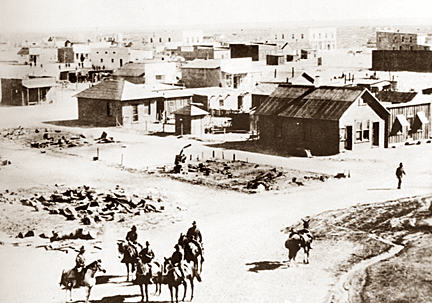 Furious that merchants in Columbus, New Mexico, had reneged on their promise
of weapons and ammunition, he attacked the town in March 1916. Furious that merchants in Columbus, New Mexico, had reneged on their promise
of weapons and ammunition, he attacked the town in March 1916.
The clincher, though, was the terrible act that had
occurred in El Paso, Texas, just two days earlier. According to reports from
the time, some 20 Mexicans had been arrested by the local police, who then
soaked them with kerosene to delouse them. Someone then set fire to the men.
It was never proven whether the fire was an accident or not. However, all 20
Mexicans were burned alive. After hearing this story, Villa's soldiers were
now ready to fight the entire American army.
At 4:45 A.M. on March 9, Villa's men rode into Columbus,
firing into the army barracks, catching the American soldiers by surprise.
Another group later rode into town shooting into houses and at any civilian
who came out. The Villistas then charged into a hotel and killed four
guests.
Villa had made history by becoming only the second foreign
military attack on American soil since the British in the War of 1812.
President Woodrow Wilson ordered General Jack Pershing to pursue Villa and
either kill him or bring him back to the U.S. to stand trial.
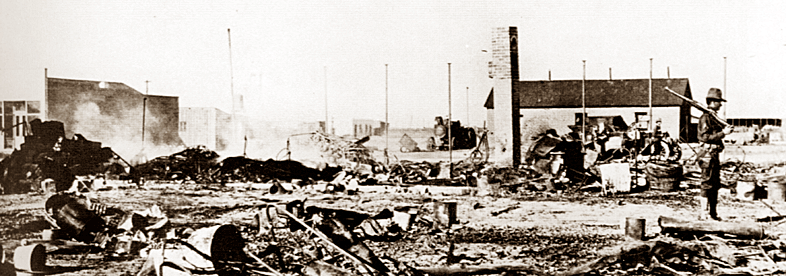
Politicians in Washington drew up a plan for the U.S. to
take over northern Mexico, since Pershing was already there and had
demonstrated his strength with his modern weapons. But the Mexican citizenry
and Carranza as well, were getting a bit tired of the Yankees. President
Wilson decided that there was too much of a possibility of an outright war
with Mexico and decided to pull the American troops back to the northern
part of Chihuahua where they would act as an incentive to the Carranza
troops, for them to either kill or catch Villa.
Today, most Mexicans remember Pancho Villa with pride for
having led the most important military campaigns of the Revolution, in which
his troops were victorious as far south as Zacatecas and Mexico City, as far
as east as Tampico, and as far west as Casas Grandes.
Retirement
After two U.S. Army "punitive expeditions" into Mexico in 1916 and
1919 failed to route Villa, the Mexican government retired Villa with
"twenty-five thousand acres of the Canutillo lands in northern
Durango." His men received lands at Rio Conchos and military pay for
one year.
 Now, in his home state of Durango, he found himself the
owner of what could easily be seen as a vast hacienda. Villa had made a
transition from peon to power. However, Villa would not forget the hard
lessons that he learned as a young man on the infamously cruel system of the
haciendas. Villa would not make the same mistakes. Now, in his home state of Durango, he found himself the
owner of what could easily be seen as a vast hacienda. Villa had made a
transition from peon to power. However, Villa would not forget the hard
lessons that he learned as a young man on the infamously cruel system of the
haciendas. Villa would not make the same mistakes.
He attempted tremendous agrarian reform on his land.
First, he studied the new, American techniques of contour plowing and crop
rotation. His agrarian reform went one step further to include not only the
crops, but also the people who tended the crops. Villa remembered the unfair
economics used by the hacienda owners and made refreshing changes.
To begin, he founded a bank which readily made loans to
farmers. The loans were provided with uncommonly low interest rates. The low
rates allowed the farmers to buy the necessary tools and seeds for their
fields. He also provided a school for the farmers’ children. Although
Villa had never received a formal education, he realized the importance of
education in providing an opportunity for the children to raise themselves
out of their dilapidated surroundings. Villa's hacienda became a miniature
example of Villa's ideal Mexico.
Assassination
Villa’s ranch lay 80 kilometers southeast of Parral, Chihuahua.
Accompanied by his entourage of Dorados, Villa frequently made trips to
Parral for banking and other errands. On the morning of July 20, 1923, Villa
had picked up a load of gold which he planned to use to pay his ranch staff
and was driving through the city in his black Dodge roadster when seven
riflemen fired 150 shots in just two minutes into his car. To this day it’s
not known for certain who ordered the killing. The authorities gave the
assassins light prison sentences, leading many people to believe that
someone in the Mexican government gave the order simply because ex-bandido
Villa had become an embarrassment to post-revolutionary Mexico.
Villa Locations Enthrall Visitors
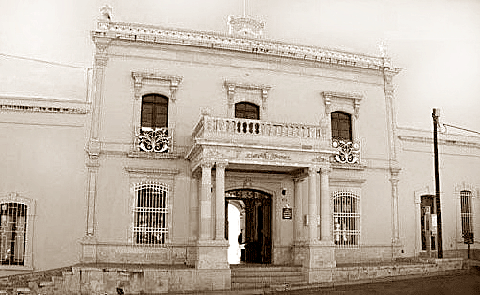 Today, visitors can stroll through Pancho Villas’ house in Chihuahua,
which he built in 1910 using the 10,000 pesos the government gave him for
his success in the Revolution. His last wife, Doña Luz Corral de Villa ,
restored several rooms to their original condition and allowed visitors in
for brief tours before she passed away in 1981.On November 17, 1982, the
Mexican Army inaugurated a museum honoring Villa, displaying an array of his
personal effects, historical photographs, revolutionary weaponry, and the
bullet-riddled black Dodge in which he was assassinated. Today, visitors can stroll through Pancho Villas’ house in Chihuahua,
which he built in 1910 using the 10,000 pesos the government gave him for
his success in the Revolution. His last wife, Doña Luz Corral de Villa ,
restored several rooms to their original condition and allowed visitors in
for brief tours before she passed away in 1981.On November 17, 1982, the
Mexican Army inaugurated a museum honoring Villa, displaying an array of his
personal effects, historical photographs, revolutionary weaponry, and the
bullet-riddled black Dodge in which he was assassinated.
In Parral, the Museo de General Francisco Villa is located
upstairs in the local library. It contains colorful murals depicting battle
scenes, all photos, old newspaper cuttings, pieces of Villa’s coffin,
weapons, and a death mask of Villa that was found at Redford college in El
Paso. A German furniture maker is said to have made the mold of Villa’s
face from which the bronze death mask was cast and then smuggled it out of
Mexico.
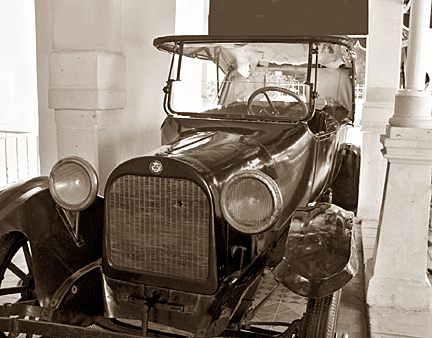 Outside on the sidewalk is a starburst shape bronze plaque
were Villa’s car ran into a tree after being riddled with bullets. It’s
the last in a series of bronze historical plaques marking Villa’s last day
route through the city. The gunfire came from the building directly opposite
the library Museum. Outside on the sidewalk is a starburst shape bronze plaque
were Villa’s car ran into a tree after being riddled with bullets. It’s
the last in a series of bronze historical plaques marking Villa’s last day
route through the city. The gunfire came from the building directly opposite
the library Museum.
Pancho Villa's grave in the Cemeterio Municipal in Parral
is a source of history nearly as bizarre as that surrounding his
assassination. Three years after his burial, someone exhumed the body and
removed his head. Most Mexicans believe a longtime rumor that says that an
American adventurer performed the decapitation on behalf of an eccentric
Chicago millionaire who collected the skulls of historic figures. As if this
weren’t bizarre enough, three years following the decapitation, the
federal government ordered Villa’s body moved to Mexico City so that he
could be interred in the Tomb of Illustrious Men.
Local residents say that their mayor had the body shifted
in the graveyard a meter or so to the right of the marked grave and replaced
with another body to prevent any more of Villa's body parts from being
taken. It was this decoy body, they insist, that was later taken to Mexico
City. Whether Villa’s headless body is still in the ground or not, his
tall, stately tombstone remains in place and people still lay flowers on the
grave.
< Back to
History Articles
Go to next History article > |
